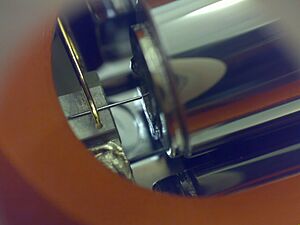Scanning tunneling microscope facts for kids

Scanning tunneling microscopy (STM) is a special tool that lets scientists see individual atoms. It was created in 1981 by two scientists, Gerd Binnig and Heinrich Rohrer, who worked at IBM Zürich. They even won the Nobel Prize in Physics in 1986 for their amazing invention!
The STM can see tiny details. It can show features on a surface as small as 0.1 nanometers (that's one ten-billionth of a meter!). It can also measure tiny height differences, as small as 0.01 nanometers. What's cool is that an STM can work in different places. It can be used in a vacuum (where there's no air), in regular air, or even in liquids and gases. It also works at most normal temperatures.
The way STM works is based on a tricky idea called quantum tunneling. Imagine a tiny metal tip brought very, very close to a surface, like a metal or semiconducting material. Even though the tip isn't touching the surface, if you apply a voltage (like from a battery), tiny electrons can actually jump across the tiny gap between the tip and the surface. This jumping of electrons is called quantum tunneling. As the tip moves across the surface, the amount of current (the flow of electrons) changes. These changes are what the STM uses to create a picture of the atoms on the surface. Using an STM can be a bit tricky because it needs very clean surfaces and super sharp tips.
How STM Works
To use an STM, the first step is to bring the scanning tip extremely close to the material you want to look at. This distance is usually only about 4 to 7 angstroms, which is incredibly small!
Then, the tip is moved very carefully across the surface. There are two main ways to do this:
- Constant Height Mode: In this mode, the tip stays at the same height as it moves. The STM measures how the current changes as the tip goes over bumps or dips on the surface. This method is faster.
- Constant Current Mode: Here, the STM adjusts the tip's height to keep the current flowing between the tip and the surface always the same. The changes in the tip's height are then used to map out the surface.
Parts of an STM
An STM machine has a few important parts that work together. These include:
- Scanning Tip: This is the super sharp metal point that gets very close to the sample.
- Movement System: This part carefully moves the tip across the surface, often using special materials that can move in tiny steps.
- Vibration Control: Because the STM is so sensitive, even tiny vibrations can mess up the image. So, the machine has parts to stop it from shaking.
- Computer: A computer collects all the information about the changing current or tip height. It then uses this data to create a detailed image of the atoms on the surface.

Related Pages
Images for kids
-
A 7 nm long part of a single-walled carbon nanotube.
-
STM nanomanipulation of PTCDA molecules on graphite to inscribe the logo of the Center for NanoScience (CeNS), Munich.
See also
 In Spanish: Microscopio de efecto túnel para niños
In Spanish: Microscopio de efecto túnel para niños







